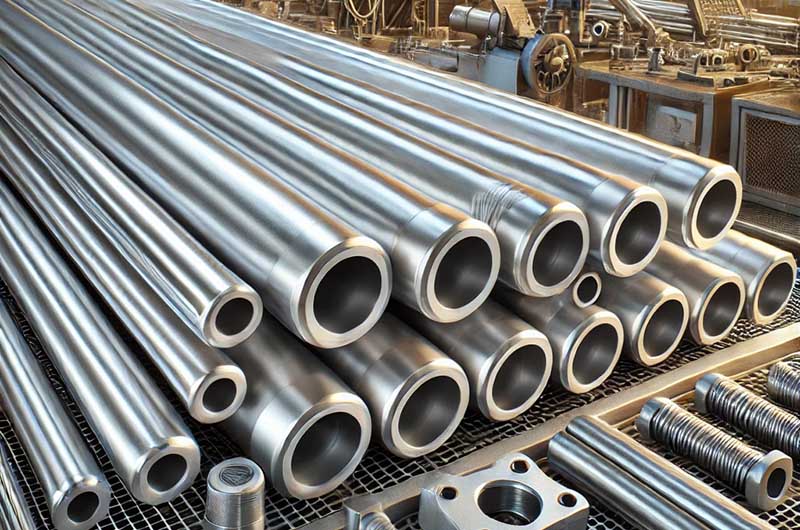3003 H14 Aluminum Tubing
3003 H14 is a manganese aluminum alloy (manganese content 1.0-1.5%), with the addition of small amounts of copper (0.05-0.2%), silicon (≤0.6%), iron (≤0.7%), and zinc (≤0.1%), thereby balancing strength and corrosion resistance. The H14 temper refers to strain hardening followed by partial annealing, resulting in moderate strength and good formability. Elongation typically ranges from 8% to 16%, depending on the testing standard, with a Brinell hardness of 40. Its density is 2.8 g/cm³, offering excellent resistance to atmospheric and marine corrosion.
3003 H14 aluminum tubing is non-heat treatable and is strain hardened to the semi-hard H14 temper. It is commonly manufactured as seamless drawn tubing in accordance with AMS 4067/ASTM B210 specifications, with an outside diameter ranging from 0.250 inches to 1.500 inches and a wall thickness from 0.035 inches to 0.065 inches. It features excellent corrosion resistance, formability, and weldability, and is widely used in heat exchangers, condensers, chemical processing, pressure vessels, and hydraulic and pneumatic systems.

3003 H14 aluminum tubing offers a combination of moderate strength, excellent corrosion resistance, and outstanding formability, all at an economical cost. It meets common aerospace and industrial standards (AMS 4067, ASTM B210/B483) and offers a wide variety of size options, making it a preferred choice for heat transfer, fluid handling, and decorative applications.
3003 H14 Aluminum Tubing Applications
- Structural Fabrication: Due to its weldability and moderate strength, it is used in frames, railings, and support structures.
- Aerospace: Its high strength-to-weight ratio allows it to be used in the manufacture of aircraft components.
- HVAC and Chemical Equipment: With a thermal conductivity of 180 W/m·K and excellent corrosion resistance, it is ideal for heat exchangers, condensers, and pressure vessels.
- Marine and Construction: Used in roofing, wall panels, and marine fittings, ensuring durability in harsh environments.
3003 H14 Aluminum Tubing Mechanical and Thermal Properties
- Tensile Strength: 160 MPa (23 ksi).
- Yield Strength: 130–145 MPa (19–21 ksi).
- Coefficient of Thermal Expansion: 23 µm/m·K, suitable for environments with wide temperature variations.
- Electrical Conductivity: 44% IACS, suitable for non-critical electrical applications.
HC 3003 H14 Aluminum Tubing Supply and Standards
- Dimensions: Outer diameter ranges from 3/16 inch to 16 inches (3–2500 mm), wall thickness ranges from 0.022 inch to 2 inches (0.2–150 mm).
- Forms: Available as seamless tubes, drawn tubes, or coiled tubing.
- Standards: Compliant with ASTM B210 (drawn tubes), ASTM B234, and AMS 4065 standards.
3003 H14 Aluminum Tubing Manufacturing and Formability
- Cold Working: Excellent bending, drawing, stamping, spinning, and roll forming capabilities.
- Weldability: Easily weldable using conventional methods (TIG, MIG); may exhibit "sticky" machining characteristics when brazed or flame cut.
- Surface Finish: Smooth and bright surface, easy to finish, paint, and anodize.
3003 H14 Aluminum Tubing Corrosion Resistance
- Atmospheric and Marine: Excellent resistance to general atmospheric corrosion and marine environments.
- Chemical Exposure: Suitable for chemical processing, food processing equipment, and pressure vessels due to its stability against various acids and alkalis.
3003 H14 Aluminum Tubing Specifications and Standards
- AMS 4067 / ASTM B210: Drawn seamless tubing for general and pressure applications.
- ASTM B483: Drawn tubing of various alloys and tempers for general purpose applications.
- WW-T-700/2: Military specification for naval fittings and hydraulic tubing.
3003 H14 Aluminum Tubing Processing Considerations
3003 H14 is known for its gummy texture, requiring sharp tools, high-speed cutting, and rigid clamping to avoid deformation. The use of coolant is recommended to reduce friction. Techniques such as rotary broaching or waterjet cutting can improve the quality of the finished product.
Key Advantages of 3003 H14 Aluminum Tubing
- Cost-effective: Balances performance and price.
- Versatility: Suitable for forming, welding, and machining processes.
- Corrosion resistance: Performs well in marine and chemical environments.
3003 H14 Aluminum Tubing Common Sizes (AMS 4067/ASTM B210):
| OD (in) | Wall (in) |
| 0.2500 | 0.0350 |
| 0.3750 | 0.0350–0.0490 |
| 0.5000 | 0.0350–0.0650 |
| 0.6250 | 0.0350–0.0650 |
| 0.7500 | 0.0350–0.0650 |
| 1.0000 | 0.0490–0.0650 |
| 1.5000 | 0.0490–0.0650 |
Typical Applications of 3003 H14 Aluminum Tubing
- Heat exchangers and condensers: HVAC, refrigeration, and automotive radiators.
- Chemical equipment and pressure vessels: Tubing in piping manifolds and process rails.
- Hydraulic and pneumatic systems: Fluid transport and control lines in machinery and aerospace.
- Food and beverage processing: Tanks, piping, and fittings for sanitary applications.
- Decorative and architectural: Railings, trims, and handrails where corrosion resistance and surface quality are required.
